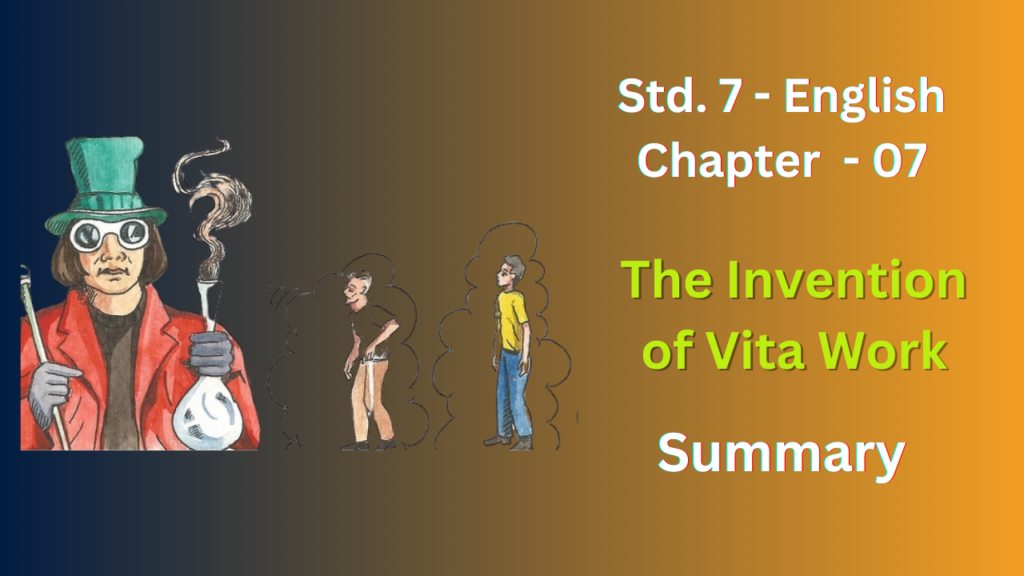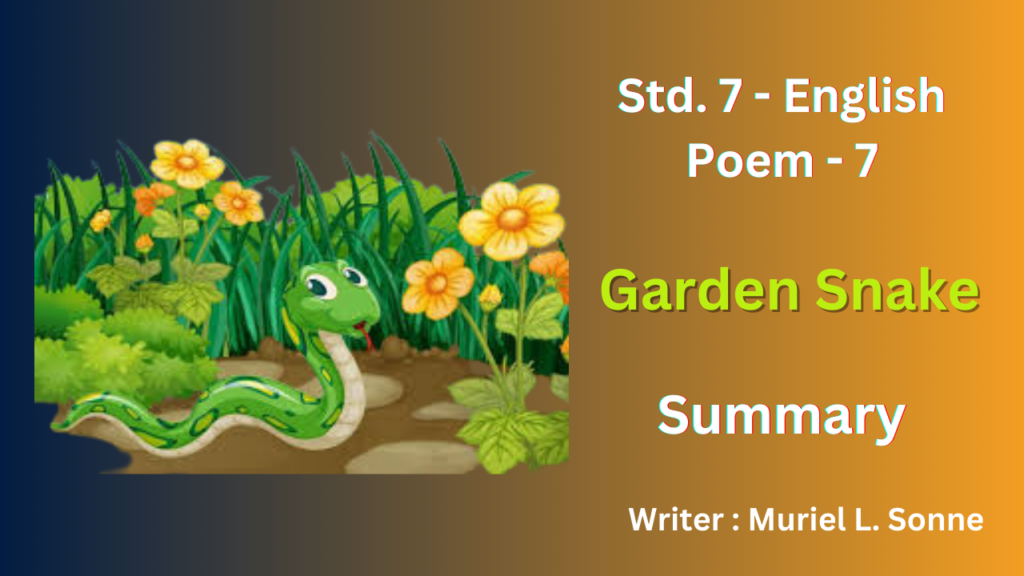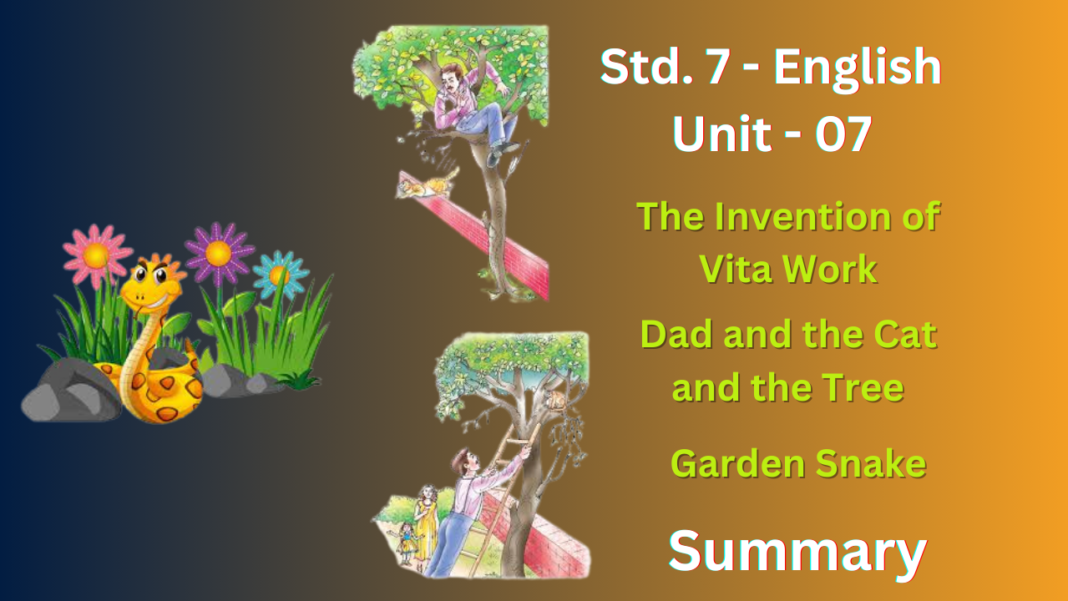NCERT Solutions for Class 7th English Chapter 7
The Invention of vita work
The Invention of Vita-Wonk: A Cautionary Tale of Age Reversal
“The Invention of Vita-Wonk” delves into the world of Mr. Willy Wonka, a renowned inventor with a penchant for the fantastical. This chapter focuses on his creation of Vita-Wonk, a concoction that alters a person’s age.
The Flawed Wonka-Vite:
Mr. Wonka’s initial attempt, Wonka-Vite, promises the allure of youth. However, its effects prove disastrous. The medicine works too efficiently, causing some people to age in reverse at an alarming rate. They vanish, their ages dipping into negative numbers, forcing them to wait years (or even decades) before reappearing! One unfortunate soul faces an 87-year wait!
The Need for Vita-Wonk:
Faced with this chaotic outcome, Mr. Wonka embarks on a new mission: inventing an antidote that reverses the negative effects and allows people to age forward.
Seeking Inspiration:
He finds himself pondering the concept of longevity. Here, Charlie, a young boy visiting his factory, plays a crucial role. Mr. Wonka asks him a simple yet profound question: “What do you think is the oldest thing in the world?” Charlie’s answer – a tree – sparks Mr. Wonka’s creativity.
Gathering Peculiar Ingredients:
Inspired by the idea of longevity found in nature, Mr. Wonka embarks on a quest for unique ingredients. These include:
- Sap from a 4,000-year-old Bristlecone Pine – This ancient tree symbolizes the essence of enduring life.
- Toenail clippings from a 168-year-old Russian farmer – This seemingly unusual component might represent the accumulation of life experiences.
- An egg laid by a 200-year-old tortoise – Turtles are known for their long lifespans, making their eggs a potential source of longevity.
A Successful Experiment:
Returning to his inventing room, Mr. Wonka mixes these peculiar ingredients into his new concoction – Vita-Wonk. To test its efficacy, he administers a small dose to a brave Oompa-Loompa volunteer. Within moments, the volunteer transforms, not younger, but demonstrably older! This successful experiment proves Vita-Wonk’s ability to reverse the effects of Wonka-Vite.
A Chapter of Caution and Curiosity:
The story concludes with the invention of Vita-Wonk, leaving the reader with several questions:
- Will Mr. Wonka use Vita-Wonk responsibly, avoiding the mistakes of Wonka-Vite?
- What are the potential side effects of Vita-Wonk?
- How will this invention impact the lives of people?
Themes Explored:
“The Invention of Vita-Wonk” explores the potential dangers of scientific advancements without proper consideration of consequences. It highlights the importance of testing and responsible use of inventions that can alter human lifespans. Additionally, the story injects a touch of humor with its quirky characters and fantastical elements, keeping the reader engaged and curious about the possibilities and limitations of Mr. Wonka’s creations.

NCERT Solutions for class 7th English Chapter 7
Comprehension Check
Choose the right answer.
(i) Mr. Willy Wonka is ……………….
(a) a cook
(b) an inventor
(c) a manager.
(ii) Wonka-Vite makes people …………
(a) older
(b) younger.
(iii) Mr.Wonka wants to invent a new thing which will make people
(a) younger,
(b) older.
Ans :
(i) (b) an inventor
(ii) (b) younger
(iii) (b) older
2. Can anyone’s age be a minus number ? What does “minus 87” mean?
Ans : No, age can’t be negative. In the story, a negative age (-87 years) means someone accidentally aged backward by 87 years with a malfunctioning invention and needs to wait 87 years to return to normal.
3. Mr. Wonka begins by asking himself two questions. What are they ?
(i) What is
(ii) What lives
Ans : Mr. Wonka asks himself two questions to find inspiration for his new invention, Vita-Wonk:
(i) What is the oldest living thing in the world?
(ii) What lives the longest?
Working with Text
1. ( i )What trees does Mr. Wonka mention ? Which tree does he say lives the longest ?
Ans : Mr. Wonka mentions trees in general but focuses on the Bristlecone Pine, claiming it lives the longest (over 4,000 years).
( ii )How long does this tree live ? Where can you find it?
Ans : The Bristlecone Pine Mr. Wonka uses is over 4,000 years old. These pines grow in high mountains, especially in California, Nevada, and the Rocky Mountains.
2. How many of the oldest living things can you remember from Mr. Wonka’s list ? (Don’t look back at the story !) Do you think all these things really exist, or are some of them purely imaginary?
Ans : Recalling from memory, Mr. Wonka mentions only one specific type of very old living thing: the Bristlecone Pine.
While the story uses fantastical elements, Bristlecone Pines are real. They are renowned for their exceptional lifespans, with some exceeding 5,000 years old.
It’s possible Mr. Wonka might have mentioned other things that live a long time, but without revisiting the story, it’s difficult to say for sure. The author might have included some imaginary creatures alongside real ones to add to the whimsical nature of Mr. Wonka’s inventions.
3. Why does Mr. Wonka collect items from the oldest things? Do you think this is the right way to begin his invention?
Ans : Mr. Wonka collects from the oldest things (like Bristlecone Pine sap) hoping their essence will make people older in his invention, Vita-Wonk. It’s creative but might not be fully scientific.
4. What happens to the volunteer who swallows four drops of the new invention ? What is the name of the invention?
Ans : Swallowing four drops of Vita-Wonk turns the volunteer into a much older man (think 70s) with wrinkled skin, hair loss, and loose teeth.
Working With Language
Fill in the blanks in the recipe given below with words from the box.” [shred cooker times tomatoes half onion oil ]
Easy Palak-Dal
INGREDIENTS
- One …….
- One cup dal
- Two thin green chillies
- ………………. a teaspoon red chilli powder
- Eight small bunches of palak .
- Two ……………….
- Salt to taste
Wash and cut the vegetables; ……………….. the palak. Put everything in a pressure………. Let the cooker whistle three …………. …………., then switch it off. Fry a few cumin seeds in ……………….. and add to the palak-dal.
Ans :
INGREDIENTS
One half onion
One cup dal
Two thin green chillies
Shred a teaspoon red chilli powder
Eight small bunches of palak
Two tomatoes
Salt to taste
Wash and cut the vegetables; shred the palak. Put everything in a pressure cooker. Let the cooker whistle three times, then switch it off. Fry a few cumin seeds in oil and add to the palak-dal.
Speaking
Using Do for Emphasis
Charlie asks, “What did happen ?” This is a way of asking the question “What happened”?” with emphasis.
Given below are a few emphatic utterances. Say them to your partner. Let your partner repeat your utterance without the emphasis. Your partner may also add something to show she/he disagrees with you.
You : I did study.
PARTNER : You studied ? I don’t believe you. Look at your marks!
You : I did go there.
PARTNER : You went there? Then…
You : I do play games.
PARTNER ………………….
You: He does read his books.
PARTNER ………………….
You : You do say the most unbelievable things!
PARTNER …………………
You: The earth does spin around.
PARTNER ………………….
You : We all do want you to come with us.
PARTNER …………………..
You : Who does know how to cook ?
PARTNER …………………….
You : I do believe that man is a thief.
PARTNER :…………..
Ans :
You: I did study!
Partner: You studied? I don’t believe you. Look at your marks!
You: I did go there.
Partner: You went there? Then why didn’t you say hello?
You: I do play games.
Partner: You do play games? But you never seem interested when I ask to join.
You: He does read his books!
Partner: He does read his books, but only when there’s nothing else to do.
You: You do say the most unbelievable things!
Partner: (Laughs) Maybe, but they’re always entertaining!
You: The earth does spin around the sun.
Partner: Of course it does! Isn’t that basic science?
You: We all do want you to come with us.
Partner: Really? That’s so sweet! I might just take you up on that offer.
You: Who does know how to cook around here?
Partner: I can whip up a few things! Don’t worry, I’ll handle dinner.
You: I do believe that man is a thief.
Partner: Maybe, maybe not. We need more evidence before jumping to conclusions.
Dad and the Cat and the Tree
Dad and the Cat and the Tree: A Tail of Feline Woe and Paternal Mishaps
“Dad and the Cat and the Tree” is a lighthearted poem that chronicles a family’s (mis)adventures in rescuing a frightened feline.
The Feline in Distress:
The poem opens with a scene of feline misfortune. A beloved cat, perched precariously high in a tree, finds itself unable to climb down. The precarious situation and the cat’s distress set the stage for the action to unfold.
Dad’s Overconfident Rescue:
Enter the father, brimming with self-assured bravado. Undeterred by the cat’s height or the tree’s potentially shaky state, he confidently dismisses any concerns. With a boastful declaration (“Right just!”), he assures everyone he’ll handle the rescue, portraying climbing a tree as a simple feat.
A Series of Slapstick Mishaps:
This initial confidence quickly evaporates as the father embarks on his rescue mission. His first attempt involves a ladder, but it proves more treacherous than anticipated. A comedic slip sends him tumbling into the flowerbed, leaving him with ruffled feathers (and likely some dirt). Undeterred by this initial setback, he devises a new, Tarzan-esque plan: swinging from a branch to reach the cat. Unfortunately, the branch, far less sturdy than he imagined, snaps, sending him plummeting to the ground once again.
An Unexpected Turn of Events:
After these two spectacular failures, Dad, perhaps a little bruised and definitely humbled, hatches a third plan. He scales the garden wall and, with a daring leap, lands squarely on the tree trunk. However, this “heroic” maneuver backfires spectacularly. Startled by the unexpected landing, the cat effortlessly jumps down to safety, leaving the bewildered father stranded in the very predicament he sought to resolve.
Humor and Irony:
The poem’s humor stems from the father’s initial overconfidence juxtaposed with his subsequent clumsiness. His boastful claims and the series of comical mishaps create a sense of amusement. The unexpected turn of events, with the cat becoming the self-assured rescuer, adds an additional layer of irony to the situation.
An Unresolved Ending:
The poem concludes without revealing how the father eventually descends from the tree. This open-endedness leaves the reader with a sense of lighthearted curiosity, wondering about the next chapter in this domestic drama. Did he require assistance? Did he manage to climb down with newfound caution? The possibilities are left to the reader’s imagination.
Themes Explored:
Beyond the humor, the poem subtly touches on themes of overconfidence, the importance of planning, and the unexpected ways situations can unfold. It also highlights the often-unpredictable nature of animal behavior, with the cat’s effortless descent leaving the bumbling human protagonist in the lurch.

NCERT Solutions for class 7th English Chapter 7
Working With the Poem
Answer the following question
1. Why was Dad sure he wouldn’t fall ?
Ans : Dad thought climbing the tree was easy (“Child’s play!”) and considered himself very capable, so he was sure he wouldn’t fall.
2. Which phrase in the poem expresses Dad’s self-confidence best?
Ans : Dad’s “Right just! Leave it to me.” best shows his confidence. It dismisses concerns and claims control.
3. Describe plan A and its consequences.
Ans : In “Dad and the Cat and the Tree,” Plan A involved using a ladder to reach the cat. Here’s how it went down:
Plan A: Dad, brimming with confidence, grabs a ladder and positions it against the tree.
Consequences: Unfortunately, the ladder proves unreliable. It slips, causing Dad to lose his footing and take a tumble, landing with a likely undignified plop in the flower bed. This failed attempt not only leaves Dad a bit worse for wear, but also highlights his initial overconfidence.
4. Plan C was a success. What went wrong then ?
Ans :
Plan C: After two failed attempts, Dad devises a new strategy. He climbs the garden wall and leaps onto the tree trunk.
Success (of sorts): From a technical standpoint, Plan C achieves its immediate goal. Dad manages to land on the tree trunk, getting closer to the cat than in his previous attempts.
The Problem: However, this “success” comes with an unexpected consequence. Startled by Dad’s sudden arrival, the cat does what cats do best – it jumps down to safety.
The Irony: The poem highlights the irony of the situation. Plan C, while getting Dad closer, ultimately backfires. He ends up stuck in the tree, the very predicament he was trying to resolve for the cat.
5. The cat was very happy to be on the ground. Pick out the phrase used to express this idea.
Ans : The phrase used in the poem “Dad and the Cat and the Tree” to express the cat’s happiness at being on the ground is:
- Smiling and smirking
6. Describe the Cat and Dad situation in the beginning and at the end of the poem.
Ans : In the beginning of “Dad and the Cat and the Tree”:
- The Cat: Stuck high up in a tree, unable to climb down and likely feeling scared or distressed.
- Dad: Confident and boastful, assuring everyone he can easily rescue the cat.
At the end of the poem:
- The Cat: Safe and happy on the ground, likely relieved to be free. The phrase “smiling and smirking” suggests a sense of satisfaction or amusement.
- Dad: Stuck in the tree himself, the situation reversed from his initial intentions. The poem doesn’t reveal his emotional state, but it’s likely a mix of frustration and embarrassment.
7. Why and when did Dad say each of the following ?
(i) Fail ?
(ii) Never mind
(iii)Funny joke
(iv) Rubbish
Ans : Here’s why these phrases wouldn’t be used by Dad in the poem:
- (i) Fail: Dad is portrayed as overconfident and unlikely to readily admit failure. He might use justifications or excuses instead.
- (ii) Never mind: This implies giving up, which doesn’t seem like Dad’s initial approach. He tries multiple plans before the situation resolves (in a way he didn’t anticipate).
- (iii) Funny joke: While the situation is ultimately funny for the reader, Dad wouldn’t likely find it humorous while stuck in the tree.
- (iv) Rubbish: This is a dismissive term, and Dad doesn’t seem to dismiss concerns initially. He downplays them but doesn’t necessarily call them rubbish.
8. Do you find the poem humorous? Read aloud lines which make you laugh
Ans : Yes, I find the poem funny! Lines like Dad’s dismissal (“Right just! Leave it to me!”) and his clumsy falls (“landed with a plop…whacko!”) create a humorous image. The cat’s smug escape (“Smiling and smirking”) adds to the amusement.
Garden Snake
The poem “Garden Snake” by Muriel L. Sonne tells a story about a child’s initial fear of snakes and their eventual understanding. Here’s the breakdown:
Initial Fear:
- The poem starts with the child encountering a snake in the garden and running away in fear. This fear is likely based on common misconceptions or societal views about snakes.
Mother’s Explanation:
- The child seeks comfort from their mother, who explains that the snake is not dangerous.
- The mother clarifies that this particular type of snake, a garden snake, is harmless and actually eats insects, which is beneficial.
A Change in Perspective:
- With their mother’s reassurance, the child’s fear subsides. The next time the child sees a garden snake, they no longer run away.
- The poem suggests the child observes the snake with curiosity, perhaps having learned to appreciate its role in the garden ecosystem.
The Lesson:
- The poem subtly conveys a message about judging things based on knowledge rather than fear. It encourages learning about things we might not understand initially.

NCERT Solutions for class 7th English Chapter 7
Working With the Poem
1. Answer the following questions
(i) Pick out the line that suggests that the child is afraid of snakes.
Ans : “I saw a snake and ran away…”
This line directly expresses the child’s reaction – seeing the snake and running away – which indicates fear.
(ii) Which line shows a complete change of the child’s attitude towards snakes?
Read it aloud.
Ans : “There’s no mistake, it’s just a harmless garden snake!”.
They can identify the snake and recognize it as harmless, a clear shift from the initial fear expressed in the poem.
(iii) But mother says that kind is good…….” What is mother referring to?
Ans : In “Garden Snake,” when the mother says “But mother says that kind is good….”, she’s referring to the specific type of snake the child encountered: the garden snake.
2. Find the word that refers to the snake’s movements in the grass. ….
Ans : The poem “Garden Snake” doesn’t mention a word for the snake’s movement, but possibilities include slides, wiggles, or glides.
3. There are four pairs of rhyming words in the poem. Say them aloud.
Ans :
- Away – Say
- Good – Food
- Grass – Pass
- Mistake – Snake
4. A snake has no legs or feet, but it moves very fast. Can you guess how? Discuss in the group.
Ans : Snakes have no legs but slither really fast! They use their muscles in waves and rough scales to grip the ground, propelling themselves forward. Imagine a caterpillar moving – similar idea!
5. Can you’recall the word used for a cobra’s long sharp teeth ? Where did you come across this word first ?
Ans : Cobras have long, sharp teeth called fangs. I learned this word from a massive dataset of text, likely including animal descriptions or snake information.
FAQ’s
What stories are covered in NCERT Solutions for Class 7th English Chapter 7?
Chapter 7 of Class 7th English includes three stories: “The Invention of Vita-Wonk,” “Dad and the Cat and the Tree,” and “Garden Snake.”
How do NCERT Solutions for Class 7th English Chapter 7 help in understanding these stories?
These solutions provide comprehensive analyses, summaries, and interpretations of each story, aiding students in grasping the themes, characters, and literary elements employed by the authors.
What is “The Invention of Vita-Wonk” about?
“The Invention of Vita-Wonk” is a whimsical tale about a miraculous invention that has the power to make people young again. It explores themes of ambition, consequences, and the pursuit of eternal youth.
What is “Dad and the Cat and the Tree” about?
This story narrates a humorous incident involving a father, a mischievous cat, and a tree. It showcases the bond between family members and the unpredictability of everyday life.
What is “Garden Snake” about?
“Garden Snake” is a narrative poem that vividly describes the encounter between the speaker and a snake in the garden. It explores themes of fear, fascination, and the beauty of nature.









